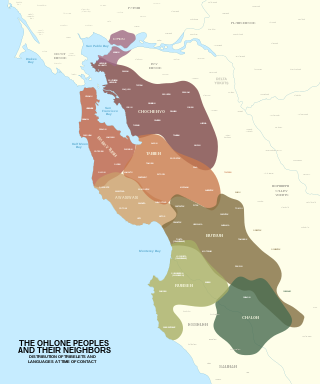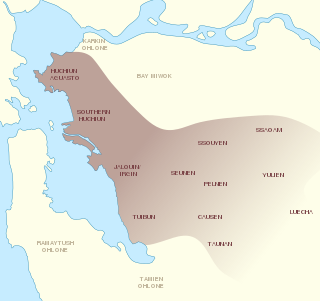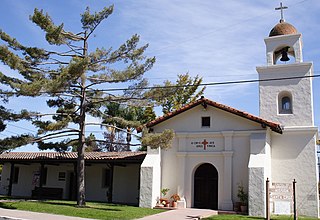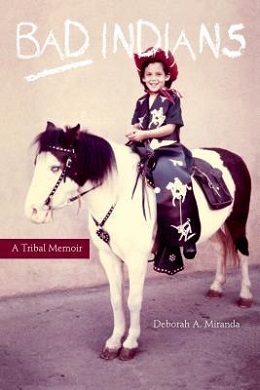Related Research Articles

The Ohlone, formerly known as Costanoans, are a Native American people of the Northern California coast. When Spanish explorers and missionaries arrived in the late 18th century, the Ohlone inhabited the area along the coast from San Francisco Bay through Monterey Bay to the lower Salinas Valley. At that time they spoke a variety of related languages. The Ohlone languages make up a sub-family of the Utian language family. Older proposals place Utian within the Penutian language phylum, while newer proposals group it as Yok-Utian.

The Rumsen language is one of eight Ohlone languages, historically spoken by the Rumsen people of Northern California. The Rumsen language was spoken from the Pajaro River to Point Sur, and on the lower courses of the Pajaro, as well as on the Salinas and Carmel Rivers, and the region of the present-day cities of Salinas, Monterey and Carmel.
The Bay Miwok are a cultural and linguistic group of Miwok, a Native American people in Northern California who live in Contra Costa County. They joined the Franciscan mission system during the early nineteenth century, suffered a devastating population decline, and lost their language as they intermarried with other native California ethnic groups and learned the Spanish language.

The Esselen are a Native American people belonging to a linguistic group in the hypothetical Hokan language family, who are indigenous to the Santa Lucia Mountains of a region south of the Big Sur River in California. Prior to Spanish colonization, they lived seasonally on the coast and inland, surviving off the plentiful seafood during the summer and acorns and wildlife during the rest of the year.

Utian is a family of Indigenous languages spoken in Northern California, United States. The Miwok and Ohlone peoples both spoke languages of the Utian language family. It has recently been argued that the Utian languages and Yokuts languages are sub-families of the Yok-Utian language family. Utian and Yokutsan have traditionally been considered part of the Penutian language phylum.

The Chalon people are one of eight divisions of the Ohlone (Costanoan) people of Native Americans who lived in Northern California. Chalon is also the name of their spoken language, listed as one of the Ohlone languages of the Utian family. Recent work suggests that Chalon may be transitional between the northern and southern groups of Ohlone languages.

Mission Indians are the indigenous peoples of California who lived in Southern California and were forcibly relocated from their traditional dwellings, villages, and homelands to live and work at 15 Franciscan missions in Southern California and the Asistencias and Estancias established between 1796 and 1823 in the Las Californias Province of the Viceroyalty of New Spain.

Kuksu was a religion in Northern California practiced by members within several Indigenous peoples of California before and during contact with the arriving European settlers. The religious belief system was held by several tribes in Central California and Northern California, from the Sacramento Valley west to the Pacific Ocean.

The Tamien people are one of eight linguistic divisions of the Ohlone (Costanoan) people groups of Native Americans who live in Northern California. The Tamien traditionally lived throughout the Santa Clara Valley. The use of the name Tamien is on record as early as 1777, it comes from the Ohlone name for the location of the first Mission Santa Clara on the Guadalupe River. Father Pena mentioned in a letter to Junipero Serra that the area around the mission was called Thamien by the native people. The missionary fathers erected the mission on January 17, 1777, at the native village of So-co-is-u-ka.

The Chochenyo are one of the divisions of the Indigenous Ohlone (Costanoan) people of Northern California. The Chochenyo reside on the east side of the San Francisco Bay, primarily in what is now Alameda County, and also Contra Costa County, from the Berkeley Hills inland to the western Diablo Range.

Isabel Meadows was an Ohlone ethnologist and the last fluent speaker of the Rumsen Ohlone language. She also spoke Esselen. She worked closely with the anthropologists from the Smithsonian Institution for more than five years in order to document her culture and language. Her work is considered fundamental in the study of Ohlone languages.
The Chalon language is one of eight Ohlone languages, historically spoken by the Chalon people of Native Americans who lived in Northern California. Also called Soledad, it belongs to the one of the Ohlone languages of the Utian family. Recent work suggests that Chalon may be transitional between the northern and southern groups of Ohlone languages.
The Tamyen language is one of eight Ohlone languages, once spoken by Tamyen people in Northern California.
The Ramaytush language is one of the eight Ohlone languages, historically spoken by the Ramaytush people who were indigenous to California. Historically, the Ramaytush inhabited the San Francisco Peninsula between San Francisco Bay and the Pacific Ocean in the area which is now San Francisco and San Mateo Counties. Ramaytush is a dialect or language within the Ohlone branch of the Utian family. The term Ramaytush was first applied to it during the 1970s.

The Rumsen are one of eight groups of the Ohlone, an indigenous people of California. Their historical territory included coastal and inland areas within what is now Monterey County, California, including the Monterey Peninsula.
The Karkin people are one of eight Ohlone peoples, indigenous peoples of California.

Awaswas, or Santa Cruz, is one of eight Ohlone languages. It was historically spoken by the Awaswas people, an indigenous people of California.
Indian Canyon is the only federally recognized Indian Country from Sonoma to the coast of Santa Barbara in California. As the only such place within the original Costanoan-Ohlone territory, anyone of Native American heritage can come to Indian Canyon to hold ceremonies on this sacred and traditional land. Until 1978, when the American Indian Religious Freedom Act was passed, Native Americans were prohibited from practicing traditional forms of spirituality.

Bad Indians: A Tribal Memoir is a mixed-genre book by Deborah Miranda published by Heyday Books in 2013. The book is part tribal history of the California Mission Indians and part family memoir. It combines different media and genres including oral histories, newspaper clippings, anthropological recordings, poems, and personal reflection to narrate the stories of Miranda’s family, who were members of the Ohlone/Costanoan – Esselen Nation, along with the experiences of California Indigenous people from the time of the Spanish missions into the present.

Linda Yamane is an Rumsien Ohlone artist and historian, and has reconstructed and "almost singlehandedly revived" the Rumsien language, Rumsien basket-making methods, and other Rumsien traditions.
References
- ↑ Miranda, Deborah. "Deborah Miranda". Hanksville.org. Karen M. Strom . Retrieved 30 January 2020.
- 1 2 3 Turner, Parrish (August 24, 2018). "Deborah A Miranda on Mixing Genres to Confront Cultural Trauma". Culture Trip. Retrieved 2 December 2021.
- ↑ War Soldier, Rose Soza (Fall 2016). "Review of Bad Indians". Wíčazo Ša Review. 31 (2): 103. doi:10.5749/wicazosareview.31.2.0103.
- ↑ "Bad NDNS: Inmate #A-93223: In the San Quentin of My Mind". 27 February 2018.
- ↑ alberthyunbiol (2017-11-23). "Deborah A. Miranda". Beyond the Single Story. Retrieved 2023-03-07.
- ↑ alberthyunbiol (2017-11-23). "Deborah A. Miranda". Beyond the Single Story. Retrieved 2023-03-07.
- ↑ Dietrich, Rene (2018). "Feeding Ourselves with Stories and Having the Gift of a Body: A Conversation with Deborah A. Miranda". American Indian Culture and Research Journal. 42 (2): 103–118. doi:10.17953/aicrj.42.2.dietrich-b.
- ↑ "Deborah A. Miranda, Thomas H. Broadus Professor of English : Washington and Lee University".
- ↑ "PEN Oakland Awards | PEN Oakland". penoakland.com. Archived from the original on 2016-11-18. Retrieved 2016-11-18.
- ↑ Furlan, Laura (Spring–Summer 2021). "The Archives of Deborah Miranda's Bad Indians". Studies in American Indian Literatures. 33 (1–2): 27. doi:10.1353/ail.2021.0003. S2CID 238907796.
- ↑ "Sovereign Erotics – UAPress". 12 July 2017. Retrieved 2019-04-06.
- ↑ Koo, Justin; Sterkin, Rachel Katharine (2021). The Routledge Handbook of Social and Political Philosophy of Language. NY: Routledge. ISBN 9781138602434.
- ↑ ""Tuolumne," by Deborah A. Miranda". 3 May 2017.